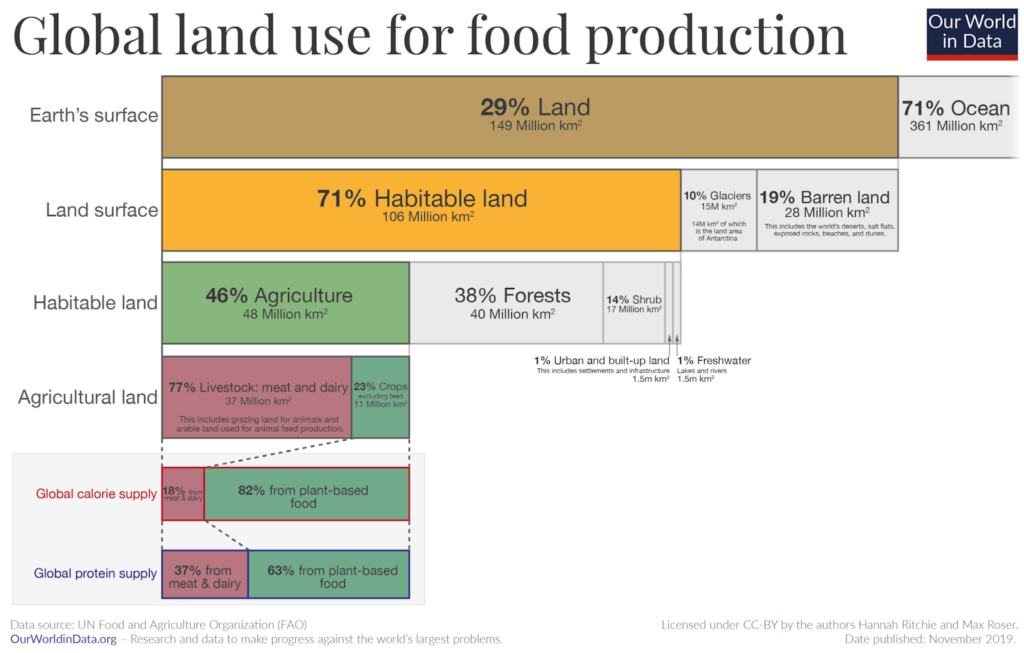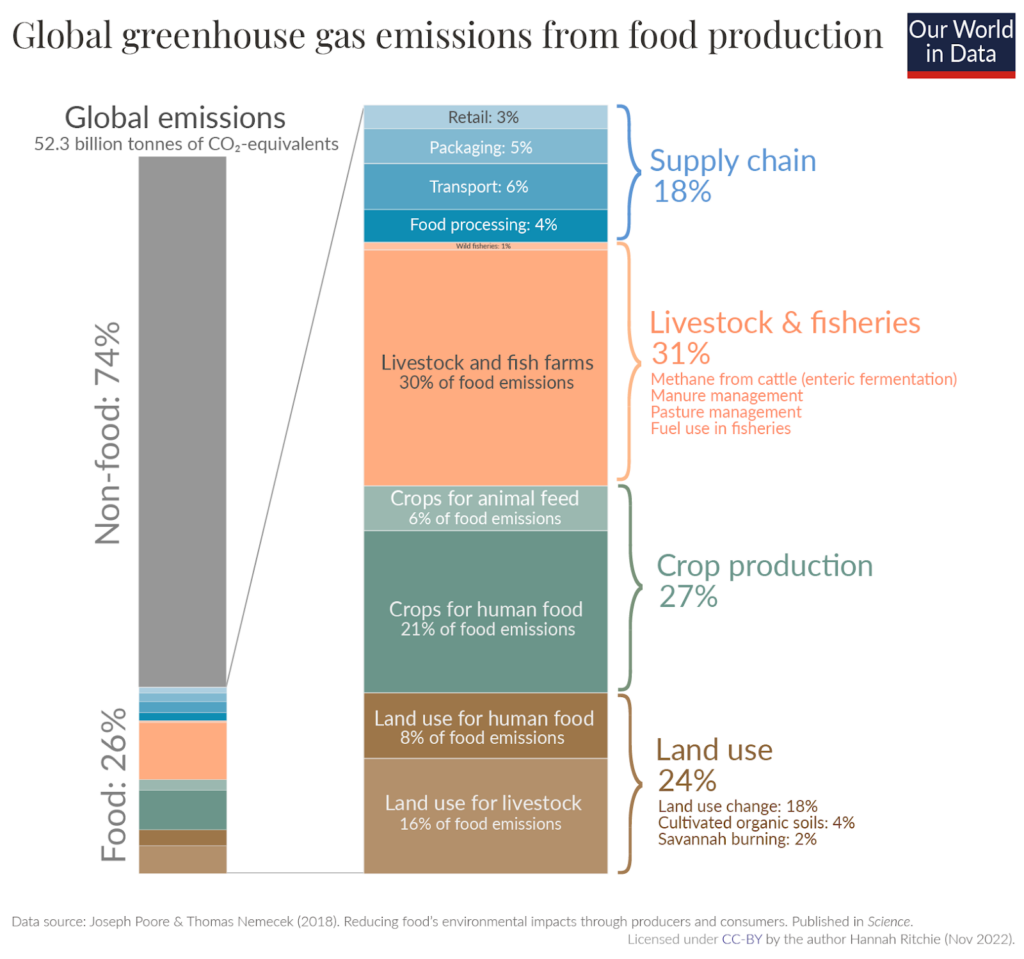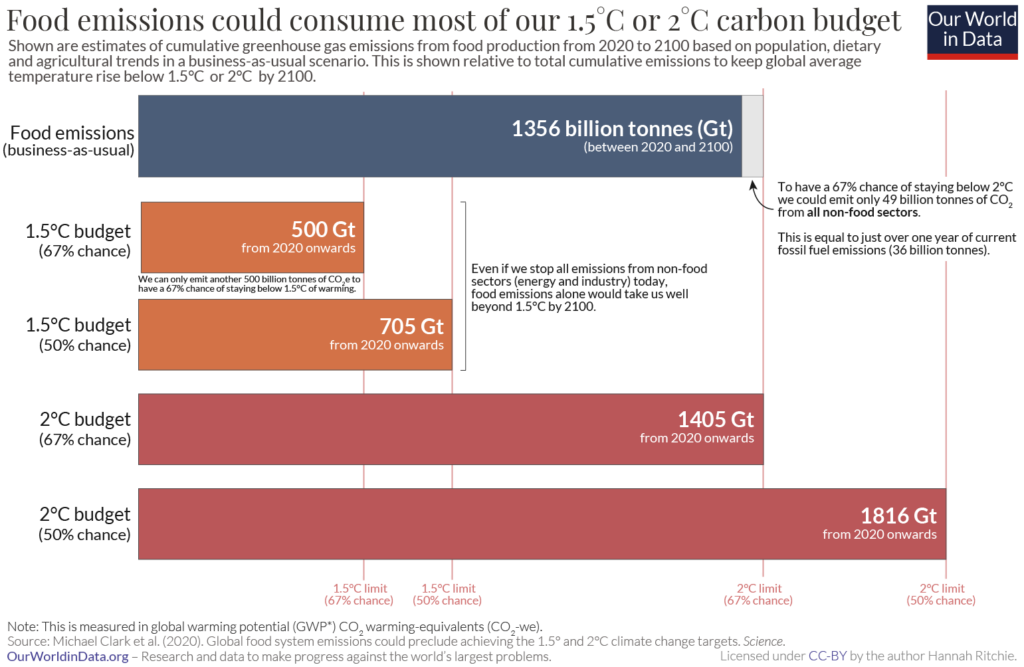Is Eating Strawberries Ethical & Sustainable? Here Are the Facts
Impactful Ninja is reader-supported. When you buy through links on our site, we may earn an affiliate commission.
Learn more
Learn more
.
Hey fellow impactful ninja ? You may have noticed that Impactful Ninja is all about providing helpful information to make a positive impact on the world and society. And that we love to link back to where we found all the information for each of our posts. Most of these links are informational-based for you to check out their primary sources with one click. But some of these links are so-called "affiliate links" to products that we recommend. First and foremost, because we believe that they add value to you. For example, when we wrote a post about the environmental impact of long showers, we came across an EPA recommendation to use WaterSense showerheads. So we linked to where you can find them. Or, for many of our posts, we also link to our favorite books on that topic so that you can get a much more holistic overview than one single blog post could provide. And when there is an affiliate program for these products, we sign up for it. For example, as Amazon Associates, we earn from qualifying purchases. First, and most importantly, we still only recommend products that we believe add value for you. When you buy something through one of our affiliate links, we may earn a small commission - but at no additional costs to you. And when you buy something through a link that is not an affiliate link, we won’t receive any commission but we’ll still be happy to have helped you. When we find products that we believe add value to you and the seller has an affiliate program, we sign up for it. When you buy something through one of our affiliate links, we may earn a small commission (at no extra costs to you). And at this point in time, all money is reinvested in sharing the most helpful content with you. This includes all operating costs for running this site and the content creation itself. You may have noticed by the way Impactful Ninja is operated that money is not the driving factor behind it. It is a passion project of mine and I love to share helpful information with you to make a positive impact on the world and society. However, it's a project in that I invest a lot of time and also quite some money. Eventually, my dream is to one day turn this passion project into my full-time job and provide even more helpful information. But that's still a long time to go. Stay impactful,Affiliate Disclosure
Why do we add these product links?
What do these affiliate links mean for you?
What do these affiliate links mean for us?
What does this mean for me personally?
![]()
Strawberries are a tasty and versatile summer treat, featured in everything from jams and smoothies to the iconic strawberry shortcake. They are popular too, with the average American consuming around 8 lbs of strawberries every year. In terms of their health benefits, strawberries contain more vitamin C than oranges and significant protein and fiber. However, there can also be many ethics and sustainability issues in the strawberry industry. So we had to ask: Is eating strawberries ethical and sustainable?
Eating strawberries is very unethical. This is mainly because there are reports of child labor in US strawberry farms, as well as low wages and unsafe conditions for workers. However, strawberry workers still make more than the federal minimum wage.
Eating strawberries is very unsustainable. This is because of their high irrigation requirements, excessive pesticide and nitrogen fertilizer application, use of plastic packaging, and high carbon footprint. However, they have fairly economic land usage compared to other fruits.
In this article, we will assess both the ethical and sustainability practices of the strawberry industry. Through these two lenses, you will be able to gain in-depth knowledge of the overall impacts of the strawberries that you eat!
Here’s How We Assessed the Ethics & Sustainability of Strawberries
The Sustainability Assessment of Food and Agriculture Systems (SAFA) is one of the ways we measure the externalities of our actions, like the consumption of strawberries. It is a holistic assessment based on the potential impact of food and agriculture operations on the environment and people. Those impacts are changes in our environment that can have adverse effects on the air, land, water, fish, and wildlife or the inhabitants of the ecosystem.
“Ethical: The discipline concerned with what is morally good and bad and morally right and wrong”
Encyclopedia Britannica
Ethics and sustainability are closely interconnected concepts that share a common objective: the well-being and preservation of our planet, including all its life and future generations.
“Sustainable: The ability to be maintained at a certain rate or level | Avoidance of the depletion of natural resources in order to maintain an ecological balance”
Oxford Dictionary
Basically, all goods and services you buy—including strawberries—leave an impact on people, animals, and our environment. And when it comes to food in general—and strawberries in specific—the following are key factors for their ethics and sustainability:
- Social and economic conditions: The ethics of food crucially depends on the social and economic conditions of the farmers who grow them. Especially on fair labor practices, including fair wages and safe working conditions.
- Seasonality: Eating seasonally is a lever of sustainability. The two key reasons are that seasonal food is more likely grown in their “natural growing season” without using greenhouses, and also more likely to be grown locally.
- Land requirements: Large parts of the world that were once covered by forests and wildlands are now used for agriculture. 10 million hectares of forest are destroyed annually and 50% of the world’s habitable land is now used for agriculture. This loss of natural habitat has been the main driver for reducing the world’s biodiversity.
- Water footprint: 70% of global freshwater is now used for agricultural purposes. By assessing the water footprint of a particular food, we can determine how our limited freshwater resources are being consumed and polluted.
- Pesticide and fertilizer usage: Pesticides and fertilizers provide a range of agricultural benefits. However, numerous studies link pesticides and fertilizers to serious effects on human health, along with disruptions to vital ecosystems and the spread of aquatic dead zones.
- Carbon footprint: The carbon footprint is one of the ways we measure the effects of our human-induced global climate change. Today, food production accounts for over a quarter (26%) of global greenhouse gas emissions.
- Waste generation: Food and its packaging account for almost 45% of the materials landfilled in the US alone. And packaging sent to landfills, especially when made from plastics, does not degrade quickly or, in some cases, at all.
To understand the overall ethics and sustainability of strawberries, we must assess each of their key factors. This Sustainability Assessment of Food and Agriculture Systems (SAFA) is a tool developed for assessing the impact of food and agriculture operations on the environment and people. And this tool helps us to evaluate whether eating strawberries is ethical & sustainable.
Here’s How Ethical & Sustainable Eating Strawberries Is
The overall ethics & sustainability of strawberries is very low. They use high amounts of irrigation and pesticides, as well as harmful nitrogen fertilizers and plastic packaging. In addition, strawberries have a high carbon footprint, and there are reports of child labor in the US industry.
There are several things that strawberries do right in terms of ethics and sustainability. For example, they have relatively economic land usage. However, there are many more things that strawberries need to significantly improve upon when it comes to their ethics and sustainability.
So, let’s have a look at the ethics & sustainability impact of each key factor of strawberries!
| Key Assessment Factors | Ethics & Sustainability |
| Social and economic conditions of strawberries | Strawberries’ social and economic conditions are very bad. This is mainly because of reports of child labor in the US and Argentina strawberry industries. |
| Seasonality of strawberries | Strawberries’ seasonality is between early spring and fall. During this time, they are typically grown in the US and are thus more sustainable than the off-season ones grown in Mexico. |
| Land requirements for strawberries | Strawberries’ land requirements are fairly average compared to other fruits. However, they are planted in monocultures so they tend to contribute to habitat loss. |
| Water footprint of strawberries | Strawberries have a fairly high water footprint of 50–75 inches of water per year. In addition, most of this water comes from irrigation. |
| Agrochemical usage for strawberries | Strawberries have high pesticide and fertilizer usage. The environmental destruction caused by pesticides and nitrogen fertilizers means that strawberries are very unsustainable at this stage. |
| Carbon footprint of strawberries | Strawberries have a fairly high carbon footprint of 0.39kg (0.88lb) of CO2e per pound of strawberries. This is mainly due to their irrigation requirements, high pesticide use, plastic packaging, and refrigeration during transportation from Mexico. |
| Waste generation of strawberries | Strawberries’ waste generation is high, both because of their plastic packaging and short shelf life. The fact that both of these things have low recycling and composting rates also contributes to their extremely low sustainability at this stage. |
These are the overall summaries, but there is a lot more to the story. In the next few sections, we will dive deeper into each stage to illustrate to you all the important aspects of strawberries’ ethics & sustainability.
How Ethical & Sustainable Are the Social and Economic Conditions for Strawberries
Strawberries’ social and economic conditions are very bad. This is mainly because of reports of child labor in the US and Argentina strawberry industries.
Everything we consume was made or harvested by somebody. In past centuries, this was often someone who lived in your community and who you might have even known personally. But through the rise of globalized distribution systems, we have become increasingly alienated from the people who make our food. This leaves a lot of room for exploitation and abuse, both of which are rampant in the food industry. Here, we will look at how the strawberry industry fares in relation to these ethical questions.
How ethical & sustainable are the social and economic conditions of growing strawberries?
- Are farmers paid fair wages to grow strawberries: Workers on California strawberry farms make around $12 an hour. This is considerably higher than the US federal minimum wage of $7.25, but still lower than California’s minimum wage of $15.50. This means that the workers on strawberry farms make less than what someone living in California would need to live on.
- How safe are the working conditions to grow strawberries: Strawberry farms have been reported as having very arduous working conditions. The main concern is the amount of bending that workers need to do on a daily basis. These are, however, fairly standard conditions among fruit farms.
- Are there reports of child or forced labor to grow strawberries: There have been reports of child labor on US strawberry farms, as well as Argentinian strawberry farms. There have also been reports of forced labor in the strawberry industry in Burma.
- What is the wider economic impact on the communities that grow strawberries: Most workers in California’s strawberry farms are migrant workers. Migrant worker programs can help with employment, but they can also leave workers vulnerable to certain exploitations.
In short, the strawberry industry’s use of child labor in the US and Argentina, as well as some of their more unsafe conditions for workers, means they are a very unethical fruit.
How Ethical & Sustainable Are the Seasonality for Strawberries
Strawberries’ seasonality is between early spring and fall. During this time, they are typically grown in the US and are thus more sustainable than the off-season ones grown in Mexico.
Every fruit has a natural season in which they grow, usually lasting a couple of months, which can range depending on the region. However, international demand for every kind of fruit is year-round. This demand is often met by importing fruits from tropical places which can grow year-round, or by growing them in greenhouses. Both of these methods use more resources and are thus less sustainable than conventional farming. Here, we will look at how the strawberry industry accommodates year-round demand.
How ethical & sustainable is it to grow strawberries in-season vs out-of-season?
- When is the natural season for growing and harvesting strawberries: Strawberries have a long season in California, from around early spring to fall. This means that only in the winter will you not be able to find in-season strawberries.
- How are strawberries naturally grown in-season: Strawberries grow on small plants. These are typically grown in California, as well as Florida and North Carolina when they are in season. This means that from spring to fall, you can typically find domestically-grown strawberries that will be more sustainable than out-of-season strawberries.
- How are strawberries grown out-of-season: Out-of-season, strawberries are mainly imported from Mexico. This means that they need more transportation and are thus less sustainable.
In short, strawberries are much more sustainable between spring and fall because they don’t need to be imported from Mexico during that time.
How Ethical & Sustainable Are the Land Requirements for Strawberries
Strawberries’ land requirements are fairly average compared to other fruits. However, they are planted in monocultures so they tend to contribute to habitat loss.

The growth stage has a major impact on fruits’ sustainability. The amount of land used, especially in relation to its expansion, the method with which they are grown, and their effect on surrounding land and wildlife are all important factors. In this section, we will look at the ways in which strawberries’ land usage affects their sustainability.
How ethical & sustainable are the land requirements for growing strawberries?
- What is the land usage of strawberries: Strawberries have a fairly average land yield of around 15–25 tons per hectare. This is more than some of the lowest land yield fruits, such as watermelons at 2–3 tons per hectare, but not as much as the highest, such as bananas, at up to 100 tons per hectare.
- Where and how are strawberries grown: Most strawberries in the world grow in the USA, primarily in California. Strawberries grow on small plants. These plants actually sequester carbon in the ground, meaning they offset some of their carbon footprint. However, strawberries are also typically grown in monocultures, meaning that they are the only plant around. Monocultures lack biodiversity and thus are bad for wildlife and soil microbes. There have been some efforts to diversify strawberry farms to improve pollination and wildlife integration, but they are still growing.
- How does the growing of strawberries affect soil fertility and erosion: Strawberries have been identified as a crop which causes serious soil erosion. As a result, they are fairly unsustainable at this stage.
- How does the strawberry industry affect the loss of habitable land: The surface area for strawberry production as of 2019 was around 400,000 hectares. This has been the result of land clearance of forests and other fragile lands. Because the global strawberry market is expected to rise, deforestation for strawberry farming is ongoing.
- How does the strawberry industry affect wildlife and biodiversity: Besides habitat loss from deforestation, strawberry farmers also frequently destroy habitats around the farms out of food safety concerns, particularly affecting birds.
In short, strawberries’ use of monoculture farming and contribution to deforestation mean that they are fairly unsustainable at this stage.
How Ethical & Sustainable Is the Water Footprint of Strawberries
Strawberries have a fairly high water footprint of 50–75 inches of water per year. In addition, most of this water comes from irrigation.
Water usage is one of the most important factors in a fruit’s sustainability. Practices like irrigation use significant resources and can cause pollution, and as such, factors like the amount of water used, where it is sourced, as well as the way they affect the water sources around them, are all important. Here, we will look at these different angles of strawberries’ water footprint.
How ethical & sustainable is the water footprint of growing strawberries?
- What is the overall water usage of strawberries: Strawberries require around 50–75 inches of water per year. This is on the higher end of water requirements amongst fruits, alongside bananas.
- What is the green water footprint of strawberries: The green water footprint is the amount of water from precipitation stored in the soil and used by plants for growth. Most strawberries consumed in the US are grown in Mexico. Mexico gets roughly 28 inches of rain per year, which is far below the water requirements of strawberries. Therefore, the majority of rain above strawberry farms in Mexico is going towards the fruits.
- What is the blue water footprint of strawberries: The blue water footprint is the amount of water sourced from surface (such as rivers or lakes) or groundwater resources. Because Mexico’s annual rainfall does not begin to cover strawberries’ water requirements, strawberries need high amounts of irrigation. Irrigation is very unsustainable, due mainly to its high carbon footprint and modification of groundwater balance. This means strawberries’ blue water footprint is very high.
- What is the gray water footprint of strawberries: The gray water footprint is the amount of freshwater required to clean up water pollution to meet certain quality standards. Essentially, it’s the amount of water needed to make polluted water clean enough to be safe and healthy for humans and the environment. Strawberries have been rated the worst offending fruit for pesticides. Pesticides pollute the groundwater, meaning that excess water is required to clean them up, leading to a higher water footprint.
- How does the strawberry industry affect freshwater and ocean pollution: Strawberries have incredibly high pesticide use and so their runoffs can greatly pollute groundwater. Their use of nitrogen fertilizer also has a considerably negative impact on groundwater and surface waters. This includes stimulating invasive algae growth in water supplies, which can be harmful to ocean life.
In short, strawberries’ intense irrigation requirements and high pesticide/fertilizer use mean their water footprint is significant.
How Ethical & Sustainable Is the Agrochemical Usage for Strawberries
Strawberries have high pesticide and fertilizer usage. The environmental destruction caused by pesticides and nitrogen fertilizers means that strawberries are very unsustainable at this stage.
Pesticides and fertilizers are agrochemicals that are very unsustainable and damaging to ecosystems. This is because they require resources to create and can easily run off into groundwater and soil systems. Here, we will look at how sustainable strawberries’ pesticide and fertilizer rates really are.
How ethical & sustainable is the agrochemical usage of growing strawberries?
- What is the pesticide usage of strawberries: A 2020 study ranked strawberries as having the highest pesticide use amongst fruits. In the same study, they found that over 90% of strawberries contained pesticide residue. This is both harmful to those eating strawberries, as well as the environment. Pesticides pollute groundwater, have a high carbon footprint, and can even harm wildlife.
- What is the fertilizer usage of strawberries: Strawberries are typically fertilized with nitrogen, phosphorus, and potassium. Though potassium is somewhat sustainable, nitrogen is very unsustainable.
- Are there any known issues connected to the agrochemical usage for strawberries: Nitrogen fertilizer has many known environmental issues. Besides stimulating invasive algae, it can also cause air pollution, plant growth problems, and damage to water and soil.
In short, strawberries’ incredibly high pesticide use and their need for nitrogen fertilizer means their sustainability is very low at this stage.
How Ethical & Sustainable Is the Carbon Footprint of Strawberries
Strawberries have a fairly high carbon footprint of 0.39kg (0.88lb) of CO2e per pound of strawberries. This is mainly due to their irrigation requirements, high pesticide use, plastic packaging, and refrigeration during transportation from Mexico.

Carbon footprint is one aspect of the overall sustainability of a fruit. It essentially measures how much carbon or other greenhouse gasses the production of fruits emits into the atmosphere. Emissions from product manufacturing, irrigation, transportation fuel, and landfills all add up to create the overall carbon footprint of a fruit. Let’s see how the carbon footprint of strawberries contributes to their overall sustainability.
How ethical & sustainable is the carbon footprint of strawberries?
- What is the overall carbon footprint of strawberries: The overall carbon footprint of strawberries is 0.39kg (0.88lb) of CO2e per pound of strawberries. This means that for every pound of strawberries consumed, strawberries emit 0.39kg of carbon. The average American consumes 8 lbs of strawberries per year, which equates to approximately 3.12kg of carbon emitted a year each, just from strawberries. This is an above-average carbon footprint among fruits.
- What are the main contributors to the carbon footprint of strawberries: The main factors that contribute to strawberries’ carbon footprint are their high irrigation and pesticide use, the need for refrigerated trucks during transport, and their use of plastic packaging.
- Which life-cycle stage of strawberries has the highest carbon footprint: The stage that contributes to strawberries’ carbon footprint the most is their growth phase because of the high carbon footprints of both irrigation and pesticides.
In short, the carbon footprint of strawberries is high, mainly due to high irrigation and pesticide requirements, plastic packaging, and refrigeration needs during transportation.
How Ethical & Sustainable Is the Waste Generation of Strawberries
Strawberries’ waste generation is high, both because of their plastic packaging and short shelf life. The fact that both of these things have low recycling and composting rates also contributes to their extremely low sustainability at this stage.
When fruit waste, either in the form of packaging or organic materials, is disposed of, it can cause a lot of problems. Whether it’s damaging wildlife, getting into oceans, emitting methane, or dissolving into microplastics that contaminate groundwater, all these materials have their part to play. The sheer amount of waste we produce is reaching a crisis point and won’t be able to continue much longer. In this section, we will look at how sustainable strawberries’ waste generation is.
How ethical & sustainable is the waste generation of strawberries?
- What is the packaging of strawberries: Strawberries are typically packaged in plastic clamshells. Plastic has devastating consequences on the environment, such as affecting ocean life, emitting greenhouse gasses in its creation, and creating toxic microplastics that get into groundwater and food.
- How is the packaging of strawberries disposed of: Plastic packaging can technically be recycled. However, their historical recycling rates have been low, at around 9%. This means that the majority of strawberry packaging is ending up in landfills. Landfills emit carbon, pollute the soil, and harm wildlife.
- How are strawberries disposed of: Strawberries have stems that many people don’t eat. These can theoretically be composted. However, food composting rates are even lower than plastic recycling rates, at around 4%. As a result, most strawberry waste ends up in landfills. On top of that, strawberries also have a shorter shelf life than other fruits. They last about a week refrigerated, whereas oranges can be kept for a month in the fridge. Therefore, strawberries are more likely to go bad before they can be eaten and thrown out whole, meaning even more strawberry waste ends up in landfills. Besides the general unsustainability of landfills, food waste causes additional harm when put in landfills through methane production.
In short, strawberries’ use of plastic packaging, as well as their short shelf life mean they are very unsustainable at this stage.
What Have Been Historical Ethics & Sustainability Issues Connected to the Strawberry Industry
Strawberries have partaken in some unethical and unsustainable farming practices over the years. These include destruction of habitats, compromising worker safety, use of monoculture farming, and pollution from nitrogen fertilizer and pesticides.
All fruits have had a complex road toward global distribution. They originate in one part of the world and often travel far to end up in your local supermarket. From farm to table, some of our favorite fruits have used unsustainable practices. Whether it’s exploiting labor, deforestation to meet demand, water pollution, or disruption of wildlife, most fruits have left a path of destruction. Many of these effects are still felt today or have even increased. Let’s see how strawberries have fared throughout history.
What have been the key ethical & sustainable issues of the strawberry industry?
- Has labor been exploited because of strawberries production: There have been several cases of the strawberry industry being exploitative to its workers. One such instance was when California strawberry farms were reportedly failing to comply with covid restrictions, putting their workers at risk. This case shows that it is possible for strawberry farmers to be negligent about their workers’ safety.
- How much land has been lost because of strawberry production: Strawberry farming has caused significant deforestation and habitat loss due to land clearance. For example, the Doñana wetlands in Spain have been greatly affected by strawberry farming. They have been protected since 1969, but in 2022 were threatened by strawberry farmers pumping their water for irrigation purposes. These kinds of threats have given the strawberry industry a negative historical track record.
- Which wildlife species have been negatively impacted or displaced because of strawberry production: Strawberries have historically partaken in some of the most harmful practices to wildlife, including pesticides, deforestation, and monoculture farming. These practices reduce biodiversity, create habitat loss, and pollute soils and groundwater.
- Have water sources and soil been contaminated because of strawberry production: Nitrogen fertilizer is one of the worst aspects of strawberry farming. In particular, water sources and soil microbes are seriously impacted by the fertilizer’s presence in farming.
In short, strawberries don’t have the best track record when it comes to historical ethical and sustainability practices. Their reports of worker endangerment, threats to protected wetlands, contribution to deforestation, and pollution of soil and water have all been harmful to the environment.
How Can You Reduce Your Environmental Impact and Offset Your Personal Carbon Footprint
There are a few things you can do to make your strawberry consumption more ethical and sustainable, while still enjoying them. You can also consider offsetting your personal and strawberry-related carbon emissions, which work to remove carbon emissions elsewhere that are then attributed to you. Here, we will walk you through how to accomplish both of these things.
How Can You Shop for Strawberries More Ethically & Sustainably
In this section, we give you a short list of ways you can consume strawberries in a more sustainable way. This list is designed to target the most unsustainable parts of strawberries’ life-cycle:
- Buy in-season strawberries: When strawberries are bought in the winter, it is likely that they were imported from Mexico, which takes more fuel. Thus, if you want to buy your strawberries more sustainably, you should make sure you buy them in the spring to fall.
- Buy strawberries without plastic packaging: Plastic packaging is one of the most unsustainable components of the strawberry industry. A good way to reduce this is by buying strawberries from local farmer’s markets or low-waste supermarkets, which tend to use less packaging.
- Compost and recycle: If you do buy strawberries with packaging, then make sure that you dispose of it properly. Recycling all plastic packaging and composting all food waste will help you to make strawberries’ waste more sustainable. If you don’t have a city-wide composting service, consider creating your own in your backyard!
Following some of these methods can really help you to make your strawberry-eating more sustainable. None of these will completely eradicate the negative impacts, since there are always effects that may be outside of your control. But some reduction is always better than nothing!
Which Organizations Can You Support to Help Promote Ethics & Sustainability
While strawberry production engages in some very unsustainable practices, there are also some organizations that help you change the parts of these processes that would otherwise be outside of your control. These organizations are working hard to prevent and reverse damage to the environment caused by industries like strawberry agriculture, towards a more sustainable future.
In the table below are some of the best charities that work in the areas where strawberry production are very unsustainable—and beyond:
Though it is helpful to boost the sustainability of your personal strawberry consumption, supporting these organizations takes your positive impact a step further. You will be reaching far beyond your own consumption impacts and helping to build a better world for everyone!
How Can You Offset Your Personal Carbon Footprint
The carbon footprint is a key part of how sustainable we live. And it is one of the ways we measure the effects of our human-induced global climate change. Yes, even from eating strawberries!
“Carbon footprint: the amount of greenhouse gasses and specifically carbon dioxide emitted by something (such as a person’s activities or a product’s manufacture and transport) during a given period”
Merriam Webster
Basically, it is the amount of carbon emitted by you as an individual or an organization providing you with goods and services – including strawberries:
- This includes GHG emissions from producing the products that we use and foods that we eat (e.g., power plants, factories or farms, and landfills)
- GHG emissions from fuel that we burn directly or indirectly (e.g., logistics and transportation, cooling or heating facilities),
- as well as the GHG emissions attributed to how we consume these products and foods.

Carbon offsets are reductions in carbon emissions that are used to compensate for carbon emissions occurring elsewhere – for example for the carbon emissions that are associated with strawberries. They are measured in tons of CO2 equivalents and are bought and sold through international brokers, online retailers, and trading platforms on what is known as the global carbon offset market.
“Carbon Offset: a way for a company or person to reduce the level of carbon dioxide for which they are responsible by paying money to a company that works to reduce the total amount produced in the world, for example by planting trees”
Oxford Dictionary
In terms of strawberries – and indeed all food types – there will always be a carbon footprint, because of the resources it takes to get your food from farms to the place where you’ll eventually eat them. And while there are ways to reduce your carbon footprint when shopping for strawberries, carbon offsets would be a way to reduce your CO2e emissions all the way down to net zero (or even to become climate positive).
However, when you purchase carbon offsets, it’s important that they actually make a difference in offsetting (aka reducing) total carbon emissions. To achieve that, the following are key criteria:
- Carbon offset projects have to be effective (different projects have different effectiveness rates)
- Carbon offset projects have to be additional
- Carbon offset projects have to be permanent
- The claims from carbon offset projects have to be verifiable
To find the best carbon offsets for you personally, check out our full guide on the best carbon offsets for individuals, where you’ll also learn more about how these carbon offset projects work, what their respective offsetting costs are, and what your best way would be to offset your own carbon emissions.
Final Thoughts
Strawberries might be a delicious and common fruit, but they are also big offenders when it comes to ethics and sustainability. They have reports of child labor in the US, they use a lot of pesticides, are planted in monocultures, and use plastic packaging, to name a few factors. But, luckily, there are efforts being made to improve strawberry agriculture’s ethics and sustainability. You as the consumer can also take part in composting, recycling, and other waste reduction initiatives to help make a more positive impact!
Stay impactful,

Sources
- All Recipes: Strawberry Jam
- Downshiftology: Strawberry Banana Smoothie
- Simply Recipes: Strawberry Shortcake
- Edible Arrangements: Fun Facts About Strawberries
- Healthline: Strawberries
- Food and Agriculture Organization of the United Nations: SAFA (Sustainability Assessment of Food and Agriculture systems) Guidelines
- Food Ethics Council: What is food ethics?
- The Fair Labor Association: Agriculture Standards
- MDPI Sustainability: Eating in Season—A Lever of Sustainability? An Interview Study on the Social Perception of Seasonal Consumption
- MDPI Foods: The Role of Local Seasonal Foods in Enhancing Sustainable Food Consumption: A Systematic Literature Review
- UN Environment Programme: Environmental Impact Assessment and Strategic Environmental Assessment: Towards an Integrated Approach
- Our World in Data: The environmental impacts of food and agriculture
- Our World in Data: Global land use for food production
- World Health Organization: Preventing disease through healthy environments: a global assessment of the burden of disease from environmental risks
- ScienceDirect (Biological Conservation): Worldwide decline of the entomofauna: A review of its drivers
- EPA: The Sources and Solutions: Agriculture
- EPA: Reducing Food Waste and Packaging
- FoodPrint: The Environmental Impact of Food Packaging
- Pennington: How to Grow Strawberries
- Impactful Ninja: What is the Carbon Footprint of Strawberries
- Agri Assembly: Cultivating Opportunities for Workers
- USA.GOV: Minimum Wage
- DIR: Minimum Wage California
- Frontiers In: Socioeconomic Challenges of California Strawberry Production
- ABC News: Feds Find Young Children Working Strawberry Farms
- Vertie: Strawberries
- Edible Schoolyard: Conditions in Strawberry Fields
- ILO: Labor Migration
- California Strawberries: Strawberry Facts
- Produce Pay: Mapping Out Strawberry Production US
- Produce Pay: Fresh Strawberry Market in the US
- Statistica: Strawberry Yield Scotland
- Impactful Ninja: What is the Carbon Footprint of Watermelons
- Impactful Ninja: What is the Carbon Footprint of Bananas
- Garden Eco: Where Do Strawberries Grow
- Panda: WWF Responds to Plans That Threaten the Donana Wetlands
- Yara: Strawberry Production Systems
- Co2 Science: Agriculture Summaries
- Organic Center: Planting More Than One Crop With Strawberries Can Help
- UKUAT: What is the Role of TCEA in Worldwide Strawberry Production
- RGS: Impacts and Consequences
- Sky Quest: Fresh Strawberry Market
- CAES: Natural Habitat Around Farms a Win For Strawberry Growers
- EOS: Monoculture Farming Explained
- RHS: How to Grow Strawberries
- Impactful Ninja: What is the Carbon Footprint of Mangoes
- Arizona: Irrigating Citrus Trees
- Water Footprint: What is a Water Footprint?
- EDIAS: An Overview of the US and Mexico’s Strawberry Industries
- Climate Knowledge Portal: Mexico
- Science Direct: Energy and Carbon Footprint of Irrigation
- World Atlas: What is the Environmental Impact of Irrigation
- Wicked Leaks: Strawberries Top “Dirty Dozen”
- USGS: Pesticides in Groundwater
- IA State: Production Guide for Commercial Strawberries
- EPA: Excess Nitrogen in the Atmosphere of Forest, Soils, and Waterways
- Pesticide.org: Pesticides and the Climate Crisis
- GOV.BC: Environmental Protection and Pesticides
- Plant Nutrition: Potassium
- Mitsui: Reducing the Environmental Impact of Chemical Fertilizers
- SAI Platform: Carbon and Water Footprint of Oranges and Strawberries
- CA Garden Web: Growing Berries in Your Backyard
- Fresh Knowledge: Transport Practices for Strawberries
- Crawford Packaging: Strawberry Packaging
- Biological Diversity: Plastic Production
- Teorra: What is the Carbon Footprint of Packaging
- UNEP: Plastic Planet: How Tiny Plastic Particles Are Polluting Our Soil
- Also Known As: 12 Interesting Facts About Packaging Waste and Disposal
- SL Recycling: What Are the Negative Effects of Landfill
- EPA: Reducing the Impact of Wasted Food
- Online Library: Practical Long-Term Storage of Strawberries
- All Recipes: How to Store Oranges
- GOV.BC: Waste Management
- The Guardian: US Coronavirus Outbreak
- DW: Mexican Strawberry Farmers Go Green
- Our World in Data: Global greenhouse gas emissions from food production
- Our World in Data: The environmental impacts of food and agriculture
- Farmers Market Coalition: Farmers Markets Promote Sustainability
- Litterless: Where to Shop
- The Guardian: The Food System We Choose Determines Biodiversity
- California Strawberries: Who is Growing Your Strawberries
- BHG: How to Compost
- Our World in Data: Greenhouse Gas Emissions per 1,000 kilocalories
- United States Environmental Protection Agency (EPA): Climate Change Terms
- Impactful Ninja: Best Charities That Advance Ethics Worldwide
- Impactful Ninja: Best Charities That Promote Sustainability
- Impactful Ninja: Best Charities That Help Farmers
- Impactful Ninja: Best Charities That Fight to Protect our Environment
- Impactful Ninja: Best Charities for Reforestation
- Impactful Ninja: Best Wildlife Conservation Charities
- Impactful Ninja: Best Charities for Protecting the Amazon Rainforest
- Impactful Ninja: Best Charities That Fight for Clean Water
- Impactful Ninja: Best Charities That Help Conserve Our Rivers
- Impactful Ninja: Best Charities to Save Our Oceans
- Impactful Ninja: Best Charities for Helping Farm Animals
- Impactful Ninja: Best Charities for Climate Change
- Impactful Ninja: Best Carbon Offsets for Individuals
- Impactful Ninja: Best Charities That Fight to Reduce Food Waste
- Impactful Ninja: Best Charities That Fight to End Plastic Pollution
- Impactful Ninja: Best Charities That Promote Recycling
- Impactful Ninja: Why Is a Carbon Footprint Bad for the Environment
- Impactful Ninja: Best Carbon Offsets for Individuals




